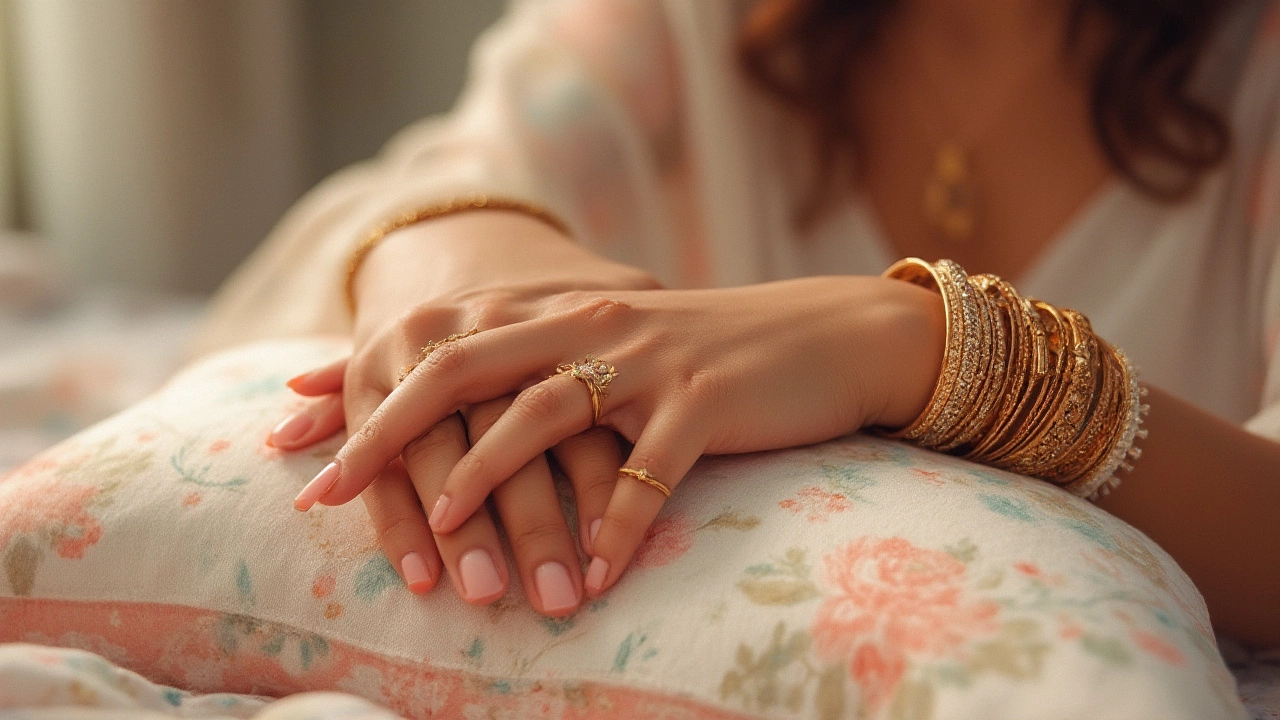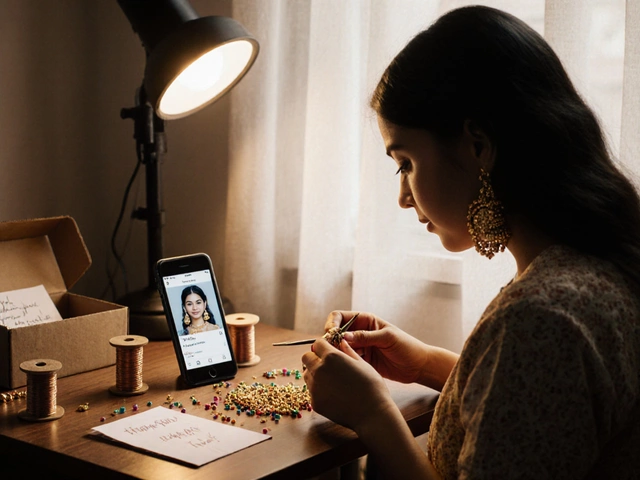Ever ended a long day with that stubborn question in your head: Should I really sleep with my bangles on? That thin clinking as you toss around, or maybe the fear of waking up with bangle-shaped marks on your wrist, makes you pause for a second. Yet, millions of women do it every night, mostly without a thought. What’s driving the habit? Is it cultural, or just comfort? More importantly—can it actually harm you, or is it totally harmless and maybe even good luck?
Why People Sleep with Bangles: Unwrapping Culture, Ritual, and Habit
Across South Asia, the bangle is way more than just another piece of jewelry. In India, for instance, married women often keep their bangles on round the clock. It’s not just for style: bangles have a deep significance, linking them to auspiciousness, health, and even marital status. If you’ve ever wondered why newlyweds get bombarded with a rainbow of glass bangles right after the wedding, it’s because bangles are seen as a symbol of prosperity. There’s even a belief that the sound of bangles wards off negative energy and promotes good fortune in the home.
In many communities, removing bangles—especially for married women—is considered inauspicious, and some see it as disrespecting tradition. For some, moving away from their hometown or country doesn’t stop the ritual; the habit sticks, even if you’ve switched from glass to gold or pearls to plastic. Bangle-wearing customs aren’t exclusive to India. In Pakistan and Bangladesh, for example, night-long bangle wearing is widely practiced, too. Nepalese women, especially married ones, wear red glass bangles called ‘chura’ as a sign of blessings and wedded bliss, both day and night.
But often it’s not only tradition. Many people just find it easier to keep their jewelry on—all those little clasps and tricky closures? Too much bother after a tiring day. So keeping bangles on for sleep becomes pure convenience, nothing more.
Surveys conducted among 1,000 Indian women in 2022 indicated nearly 65% sleep with their bangles on at least four nights a week (source: Lifestyle Fashion Trends Survey, Mumbai). Reasons ranged from honoring family tradition to simply forgetting or dreading taking them off. And let’s not overlook that familiar sense of comfort for some: a clinking reminder of home, love, and family—you don’t just take that off at night.

How Sleeping with Bangles Impacts Comfort, Sleep Quality, and Health
Alright, putting culture aside, what about physical comfort? Sleep experts and dermatologists tend to agree: there isn’t a universal answer. The outcome depends on your bangles—their material, size, number, and how they fit. Here’s where things get interesting.
Start with the obvious—hard glass bangles. They look gorgeous, but they’re brittle and breakable. If you accidentally roll onto your hand, glass bangles can snap or chip, which increases the risk of cuts. Not ideal, especially for people who move a lot during sleep. Plus, broken glass shards can poke through bedsheets and create hidden hazards.
Now, metal bangles, especially gold and silver, are more forgiving but not indestructible. They might get dented, lose shape, or develop sharp edges over time with constant friction on hard surfaces like your nightstand or mattress. The jingling sound can also be surprisingly loud at 2 am—your partner might start to bear a grudge! For light sleepers or those sharing a bed, the noise alone can be a dealbreaker.
Plastic or silicone bangles are safest for sleeping because they’re flexible and less likely to break. But beware of skin irritation, especially if you sweat at night. Many people discover rash or mild redness on wrists by morning. Bangles that are too tight might restrict blood flow. You might wake up with purple marks or numb fingers—which is a clear hint to switch to a larger size or rethink wearing them at night.
Researchers at the Indian Association of Dermatologists (2023) studied 500 regular bangle-wearers and found that 37% reported occasional mild redness, and 12% often woke up with pressure marks. Rare cases of contact dermatitis—skin reactions to metal alloys—were also seen, especially in cheap imitation bangles with nickel, an allergen. If you’re seeing unusual black, blue, or green marks, that’s probably a chemical reaction between sweat and the metal alloy. High humidity and summer nights tend to make this worse.
There’s another subtle risk—not obvious to everyone. Bangles can sometimes get stuck under your pillow or entangle with bedsheet threads, leading to awkward, painful moments in the morning. This is especially true for stacked bangles, layered styles, or those embellished with dangling charms.
Here's a quick data table summarizing the main points:
| Bangle Type | Comfort Level | Risk of Injury | Likely Nighttime Issues |
|---|---|---|---|
| Glass | Low | High | Breakage, cuts, loud sound |
| Metal (gold/silver) | Medium | Medium | Dents, pressure marks, allergic rash |
| Plastic/Silicone | High | Low | Possible irritation, sweating, flexibility |
There’s a mental angle too. Some folks say that feeling their bangles at night makes them more secure, which can lower stress or anxiety. But the flip side? Repeated waking from sound or discomfort adds up to less restful sleep. Bad sleep comes with its own list of health downsides over time, from irritability to chronic fatigue.
If you notice wrist pain or numbness after nights with bangles, don’t ignore it. Your nerves and blood vessels deserve a break. If you scratch yourself easily, or you sweat overnight, consider giving your skin a breather and removing bangles before falling asleep. Moisturize your hands and wrists to soothe stressed skin.

Tips for Safe and Comfortable Sleeping with Bangles
Not ready to ditch your bangles at bedtime? There are ways to juggle tradition, comfort, and safety. Practicality does not need to cancel out style, even when the lights are out. Here’s what works for people who can’t part with their wrist bling when sleep calls:
- Go for lightweight designs: Slim, smooth bangles—think thin gold or lightweight plastic—tend to have fewer issues. Skip heavy, chunky styles at night.
- Choose a snug but not tight fit:
- Loose bangles slide and jangle, while tight ones leave marks. A finger should slip between bangle and wrist comfortably.
- Favor rounded edges:
- Bangles with sharp or squared edges will dig in overnight. Look for softly rounded or gently curved bangles for bedtime.
- Avoid fragile materials:
- Glass or crystal bangles are more likely to break and cause injury. Switch to metal, plastic, or silicone overnight.
- Clean your bangles regularly:
- Dirt, lotion, and sweat trapped under bangles can irritate skin. Clean with a damp cloth and let dry before wearing again at night.
- Watch for signs of irritation:
- Any itchiness, rash, or unusual color on your wrist is a warning sign—give your skin a break, moisturize, or switch material.
If your traditions require keeping bangles on, save the heavy-duty sets for daywear and rotate comfortable options for nighttime.
If you’re worried about sleep quality, try tracking your sleep for a week with and without bangles. Use a smartwatch or sleep app. Compare results—many people are surprised by how much deeper they rest when wrists are free.
For those who travel or work odd hours, travel-friendly, no-jingle silicone bangles that look like the real deal are a lifesaver. They won’t snap, break or jingle through the night. Teens and kids following family traditions can benefit from these too, since small wrists are more prone to skin damage.
If a medical condition like eczema, psoriasis, or carpal tunnel is in the picture, talk to your doctor before making bangles a 24/7 habit. Even simple precautions—like slipping a thin silk scarf between bangles and wrist—can help.
There’s also a social angle. If your household treats removing bangles as breaking tradition, consider discussing these tips with elders. Sometimes, a practical compromise—say, wearing just one cherished bangle—does the trick. Cultural respect and physical health can go hand in hand, even with something as simple as what you wear on your wrist at night.
There’s no universal rule. Listen to your body, honor the tradition in a way that works for you, and don’t lose sleep—literally—over bangles. Who knew that a small piece of jewelry could keep you thinking so late at night?



